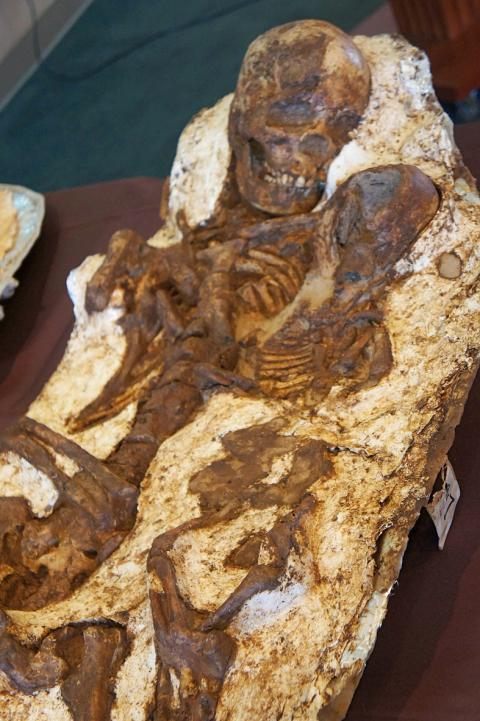Around 4,800 years ago, near what is now the Taiwanese coast, a young mother passed away, leaving behind a poignant scene of love and loss. When archaeologists carefully excavated her grave, they made a remarkable discovery—she had been buried with her six-month-old infant nestled in her arms. The positioning of the pair, interred close to a stone dwelling, suggested they had been laid to rest in a tender embrace, possibly by loved ones who sought to preserve their bond even in death.

The exact cause of their deaths remains unknown, but joint burials like this are considered rare among the Stone Age cultures of Taiwan. This extraordinary find sheds light on the funerary customs of ancient peoples and raises questions about the emotional and cultural significance of such burials.
“The young mother holding the baby was the most surprising discovery for us,” explains Chu Whei-Lee, an archaeologist from Taiwan’s National Museum of Science. She speculates that their remains might have been buried beneath a house by those who cared for them, though further evidence is needed to confirm this hypothesis.
Traces of the Past: Sharks and Agriculture
The mother and child were unearthed as part of a broader excavation conducted at the An-ho archaeological site, located in Taichung City, along Taiwan’s western coast. The site, which dates back to the Neolithic period, was actively used for at least 800 years. Today, An-ho lies approximately 6.2 miles (10 kilometers) inland, but in ancient times, the coastline was different, and it is likely that the site was once much closer to the sea.
Archaeologists found over 200 shark teeth scattered throughout the settlement, including within dwellings, ash pits, and graves, offering a strong indication that the sea played a crucial role in the daily lives of the people who lived there. According to Chu, the presence of these teeth suggests that the inhabitants relied on marine resources, either for sustenance, trade, or possibly even for symbolic or ritualistic purposes.
Despite not being the oldest known human settlement in Taiwan, An-ho is believed to be the earliest site associated with the Dabenkeng culture in this region. Dabenkeng settlements first appeared along Taiwan’s coastline around 5,000 years ago, and their sudden emergence has led archaeologists to believe that the people who established these settlements migrated to the island rather than evolving from pre-existing local cultures.
The Arrival of Taiwan’s First Farmers
Chengwha Tsang, an archaeologist at Taiwan’s Academia Sinica, explains that the Dabenkeng people were Taiwan’s first known farmers. He believes they may have originated from the southern and southeastern coasts of China and arrived on the island approximately 5,000 years ago. This migration marked the introduction of Neolithic culture to Taiwan, bringing with it significant advancements in agriculture, pottery, and social organization.
The spread of the Dabenkeng culture is particularly significant because these early settlers may have played a foundational role in the expansion of Austronesian-speaking peoples. From Taiwan, their descendants are thought to have dispersed across vast stretches of Oceania and Southeast Asia, carrying their agricultural practices, seafaring skills, and linguistic traditions with them.
“They were probably the earliest ancestors of the Austronesian language-speaking people who now live in Taiwan and across the Pacific islands,” Tsang notes. This perspective aligns with linguistic and genetic research, which suggests that Austronesian expansion began in Taiwan before spreading to the Philippines, Indonesia, and beyond.
Understanding Ancient Burial Practices
The excavation at An-ho not only provides insights into the daily lives of the Dabenkeng people but also offers valuable information about their burial customs and attitudes toward death.
The mother and child were found among at least 48 graves at the site, including the burials of five young children. Many of these graves contained funerary objects such as pottery, indicating that burial offerings were an important aspect of their rituals. The bodies were laid out in a north-south orientation and placed on their backs—an unusual practice compared to the prone (facedown) burials commonly found in other Taichung burial sites.
This variation in burial posture suggests that the Dabenkeng people may have followed distinct funerary traditions that set them apart from other Neolithic groups in the region. The placement of the mother and infant, in particular, implies a deeply ingrained cultural reverence for familial bonds, even in death.
To gain a deeper understanding of the people buried at An-ho, archaeologists have extracted DNA from the remains and sent it for analysis. This genetic research could provide crucial insights into the relationships between the Dabenkeng people, Taiwan’s Indigenous populations, and broader Austronesian cultures.
By studying these remains, researchers hope to piece together the complex history of human migration, cultural exchange, and adaptation that shaped early Taiwan. The discovery of the mother and child, resting together in an embrace frozen in time, serves as a poignant reminder of our shared humanity across millennia—one that transcends cultures, languages, and the passage of time.





